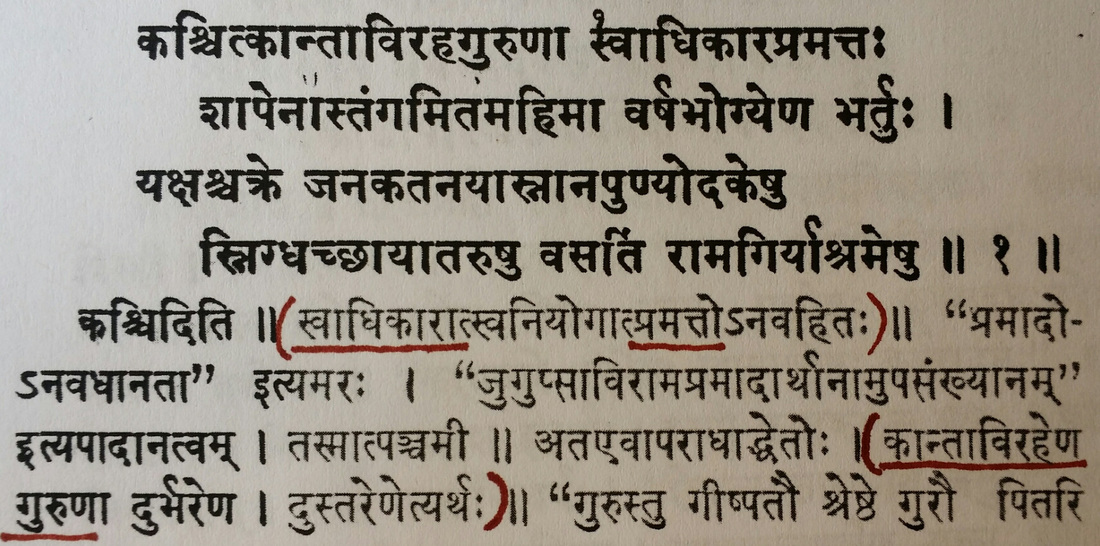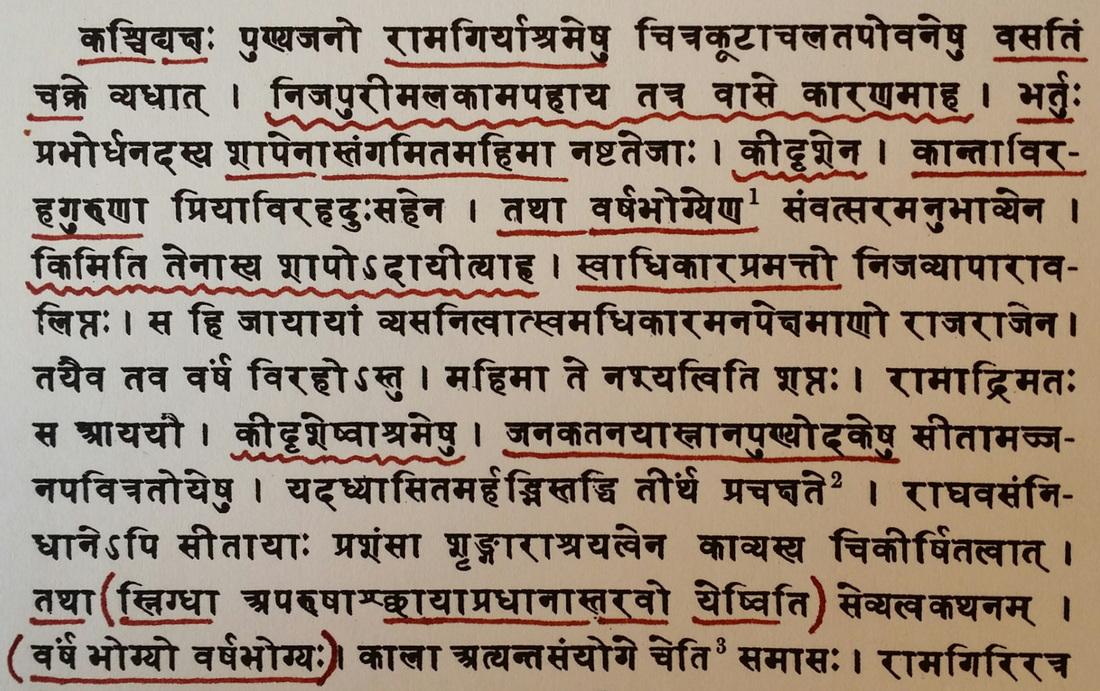मेघदूतम्
Examples & Exercises
Translating by Anvaya
- (कश्चित्) यक्षः (रामगिर्याश्रमेषु) वसतिं चक्रे । “A (certain) yakṣa took up residence (in the hermitages of Rāma’s mountain).”
* While it is common to think of Sanskrit as an “SOV” language, the Sanskrit tradition itself more accurately thinks of normative word order in terms of semantic roles (and not grammatical marking). That is, the order given by the tradition is not Nominative (S) Accusative (O) Verb (V), but agent (कर्तृ), patient (कर्मन्), action (क्रिया). For active voice sentences, this does yield an SOV order since—in the active—the Subject and Object are the agent and patient respectively. But for passive sentences (specifically कर्मणि प्रयोग), it yields an Instrumental-Subject-Verb order, since in those passives the agent is in the Instrumental and the patient is the Subject. This is why Deshpande regularly places the instrumental agent before the nominative patient in passives beginning in Lesson 16: e.g., मया नृपस्य दासो दृश्यते । (and not नृपस्य दासो मया दृश्यते ।).
Kathaṃbhūtinī Excursus
Analysis and Translation
- grammatically — identifying the forms of nouns, verbs, etc.
- syntactically — identifying subjects, predicates and their dependents (gerund clauses, participial clauses, genitives, and other complements)
- analytically — identifying compounds and subcompounds
मेघदूतम् ॥१॥ |
||||||
S |
adj 1 |
|||||
→ (यक्षः) |
||||||
(स्वाधिकारात् |
प्रमत्तः) |
|||||
m.s.abl. (कर्मधारयः) |
m.s.nom. (पञ्चमी-तत्पुरुषः) |
|||||
from his official duties |
having deviated |
|||||
- |
||||||
adj 2 (and its series of dependents) |
||||||
→ (शापेन) |
→ (शापेन) |
→ |
→ |
→ (यक्षः) |
||
(कान्ताविरहेण |
गुरुणा) |
वर्षभोग्येण |
भर्तुः |
शापेन |
(अस्तंगमितो महिमा यस्य सः) |
|
m.s.ins. (तृतीया-तत्पुरुषः) |
m.s.ins. (तृतीया-तत्पुरुषः) |
m.s.ins. (द्वितीया-तत्पुरुषः) |
m.s.gen. |
m.s.ins. |
m.s.nom. (समानाधिकरण-बहुव्रीहिः) |
|
due to separation from his beloved |
difficult |
to be suffered for a year |
master’s |
by a curse |
whose power was caused to end |
|
- |
||||||
adj 3 |
subject |
|||||
→ |
||||||
कश्चित् |
यक्षः |
|||||
m.s.nom. |
m.s.nom. |
|||||
a certain |
yakṣa |
|||||
- |
||||||
P |
adj 1 |
|||||
→ (आश्रमेषु) |
||||||
(जनकतनयायाः |
स्नानैः |
पुण्यानि उदकानि येषु तेषु) |
||||
f.s.gen. (षष्ठी-तत्पुरुषः) |
n.pl.ins. |
m.pl.loc. (समानाधिकरण-बहुव्रीहिः) |
||||
of Janaka’s daughter |
because of the ablutions |
those in which the waters were pure |
||||
- |
||||||
adj 2 |
locative complement |
|||||
→ |
→ |
|||||
(छायाप्रधानाः तरवः छायातरवः) |
(रामगिरेः आश्रमेषु) |
|||||
(मध्यमपदलोपि-कर्मधारयः) |
m.pl.loc. (षष्ठी-तत्पुरुषः) |
|||||
(shade-rich trees = shade-trees) those in which the shade-trees are densely clustered |
in the hermitages of Rāma’s mountain |
|||||
- |
||||||
object |
verb |
|||||
→ |
||||||
वसतिम् |
चक्रे |
|||||
f.s.acc. |
3rd s. Ā. perf. √कृ |
|||||
residence |
made |
|||||
- words precede the words on which they depend, and
- adjectives that precede their substantives are attributive, not predicative
- स्वाधिकारात् प्रमत्तः कश्चित् यक्षः, “Having deviated from his official duties, a certain yakṣa....” (i.e., with प्रमत्तः as an attributive adj. Note that both Mallinātha and Vallabhadeva take this adj. as a हेतुगर्भविशेषण, a causal adj., providing the reason for the yakṣa’s curse. So one could also translate along the lines of “Because (he’d) deviated....” Finally, the ‘deviation’ here is “carelessness” or “negligence” as Amara defines प्रमादो ऽनवधानता, “pramāda means inattention/carelessness/negligence,” and the Vārttika on Pāṇini 1.4.24 stipulates that actions in the sense of प्रमाद govern the ablative (as with स्वाधिकारात् here). So we could also translate: “because he’d been negligent of his official duties”)
- अस्तंगमितो महिमा यस्य सः कश्चित् यक्षः, “A certain yakṣa, whose power had been caused to end (i.e., had been ended or suspended),....”
- and since शापेन immediately precedes अस्तंगमितमहिमा, it must qualify it: “whose power had been suspended by a curse,” where we see that शापेन specifically qualifies the causative past passive participle, गमित
- the remaining adjectives in the instrumental preceding शापेन must agree with it as attributives: कान्ताविरहेण गुरुणा वर्षभोग्येण शापेन, suspended “by a curse (that was) heavy (i.e., hard to bear) because of his separation from his beloved (and was) to be suffered for a year” (Mallinātha justifies his gloss of गुरु as दुर्भर, “hard to bear,” on the authority of the शब्दार्णव lexicon)
- the anvaya is a good reminder that genitives will come between a substantive and its adjectives: वर्षभोग्येण भर्तुः शापेन, “by his master’s curse (which was) to be suffered for a year....”
Having been negligent of his official duties,
कान्ताविरहगुरुणा वर्षभोग्येण भर्तुः शापेन अस्तंगमितमहिमा
his power (thus) suspended by his master’s curse—(which was) to be suffered for a year (and was) hard to bear because of his separation from his beloved—
कश्चित् यक्षः वसतिं चक्रे
a certain yakṣa took up residence
स्निग्धच्छायातरुषु रामगिर्याश्रमेषु
in the hermitages of Rāma’s mountain, in which (hermitages) the shade-trees were densely clustered
जनकतनयास्नानपुण्योदकेषु
(and in which) the waters were pure because of Janaka’s daughter’s ablutions.
|
kaścit kāntā-/viraha-guruṇā / svâdhikāra-pramattaḥ
śāpenâstaṃ-/gamita-mahimā / varṣa-bhogyeṇa bhartuḥ | yakṣaś cakre / janaka-tanayā-/snāna-puṇyôdakeṣu snigdha-cchāyā-/taruṣu vasatiṃ / rāma-giry-āśrameṣu || |
- N-I-N in A, and I-N-I in B (concluding with N.../ in C)
- N.../.../N ...N-/N/... and ...I-/I/... I.../.../I....
|
तस्मिन्नद्रौ कतिचिदबलाविप्रयुक्तः स कामी
नीत्वा मासान्कनकवलयभ्रंशरिक्तप्रकोष्ठः । आषाढस्य प्रथमदिवसे मेघमाश्लिष्टसानुं वप्रक्रीडापरिणतगजप्रेक्षणीयं ददर्श ॥२॥ “On that mountain the loving husband, separated from his wife, several months did spend. His forearms bare with the fall of his golden bracelets, on the first day of Āṣāḍha a cloud clinging to a mountainpeak did he see, resembling an elephant playfully stooping (to butt) a rampart.” |
|
tasminn adrau / katicid abalā-/viprayuktaḥ sa kāmī
nītvā māsān / kanaka-valaya-/bhraṃśa-rikta-prakoṣṭhaḥ | āṣāḍhasya / prathama-divase / megham āśliṣṭa-sānuṃ vapra-krīḍā-/pariṇata-gaja-/prekṣaṇīyaṃ dadarśa || |
Exercises
- Underline the anvaya and base text as described on the commentary webpage, delineating vigrahas with parentheses, etc.
- Rewrite the anvaya and label its grammar as above. At the same time, indicate the displayed syntactic dependencies (e.g., with arrows).
- Translate the core predication(s) of the verse’s sentence(s); then translate the anvaya according to its syntactic units (as above).
- Return to the verse and retranslate it by pāda (or yati) where possible and comment on the work the metrical syntax seems to be doing, if any.



